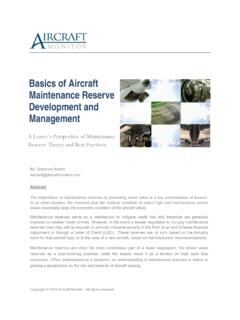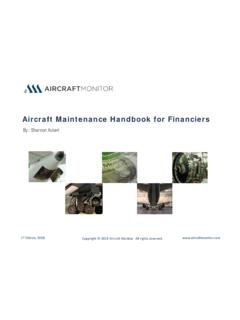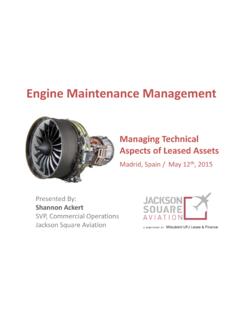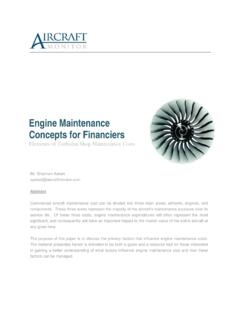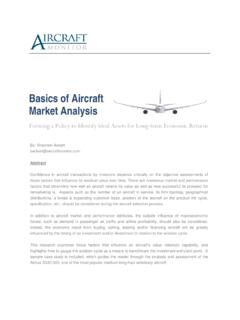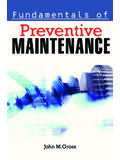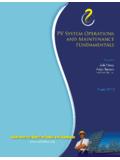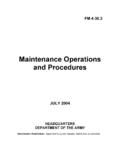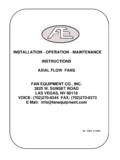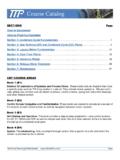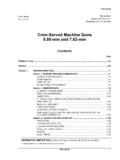Transcription of Basics of Aircraft Maintenance Programs for …
1 Basics of Aircraft Maintenance . Programs for financiers Evaluation & Insights of Commercial Aircraft Maintenance Programs By: Mr. Shannon P. Ackert Abstract Knowledge of an air carrier's Maintenance program is essential in order to gain visibility into an Aircraft 's Maintenance status, and to identify outstanding issues related to lease or purchase requirements. This report assembles the detailed information required to understand the fundamentals of Aircraft Maintenance Programs ; from the origins of Maintenance program development to today's process using MSG-3 decision logic as a tool. In addition, the report serves as a guide to educate readers with officially recognized Maintenance program terminologies, processes, and common practices. Date of Issue: October 1, 2010 . Basics of Aircraft Maintenance Programs for financiers Evaluation & Insights of Commercial Aircraft Maintenance Programs TABLE OF CONTENTS.
2 1. INTRODUCTION .. 2. 2. Aircraft Maintenance PERSPECTIVE .. 2. Maintenance Program History .. 2. Maintenance Steering Group (MSG) Processes .. 3. Maintenance Task Development .. 6. Maintenance Program Groupings . 7. 3. Maintenance PROGRAM DEVELOPMENT .. 7. Maintenance Review Board Report (MRBR) Process .. 7. Maintenance Review Board (MRB) 8. Industry Steering Committee (ISC) .. 8. Maintenance Working Groups (MWG) .. 8. Policy & Procedures Handbook (PPH) .. 8. Maintenance Planning Document (MPD) .. 9. Certification Maintenance Requirements (CMR) .. 9. Airworthiness Limitations (AL) . 9. Operator Aircraft Maintenance Program (OAMP) .. 9. Maintenance Program Supporting Documents .. 10. Maintenance Program Enhancement Process . 11. Generic versus Customized Maintenance Program 11. Basics of Aircraft Maintenance Programs for financiers | 10/1/2010.
3 4. Maintenance CHECKS.. 12. Maintenance Letter Checks .. 12. Maintenance Check Packaging .. 14. 5. Maintenance STORAGE PROGRAM .. 15. 6. Maintenance PROGRAM BRIDGING .. 16. 7. Maintenance PROGRAM VALUATION PERSPECTIVE ..17. 8. APPENDIX 1 EXAMPLE BLOCK & PHASE Maintenance PROGRAM STRUCTURE .. 18. 9. APPENDIX 2 MPD TASK IDENTIFICATION .. 19. 10. APPENDIX 3 Aircraft STORAGE PROGRAM TYPICAL ROUTINE TASKS .. 21. 11. REFERENCES .. 22. 12. ACKOWLEDEMENTS . 22. 1. INTRODUCTION. The industry definition of Maintenance generally includes those tasks required to restore or maintain an Aircraft 's systems, components, and structures in an airworthy condition. Maintenance is required for three principal reasons: x Operational: To keep the Aircraft in a serviceable and reliable condition so as to generate revenue. x Value Retention: To maintain the current and future value of the Aircraft by minimizing the physical deterioration of the Aircraft throughout its life.
4 X Regulatory Requirements: The condition and the Maintenance of Aircraft are regulated by the aviation authorities of the jurisdiction in which the Aircraft is registered. Such requirements establish standards for repair, periodic overhauls, and alteration by requiring that the owner or operator establish an airworthiness Maintenance and inspection program to be carried out by certified individuals qualified to issue an airworthiness certificate. Maintenance PROGRAM PERSPECTIVE. Maintenance Program History - In the early days of aviation Maintenance Programs were developed primarily by pilots and mechanics. They assessed an Aircraft 's needs for Maintenance based on their individual experiences and created Programs that were simple and devoid of analysis. The introduction of the airlines as a new method of transport demanded new regulations and broader involvement of the Regulatory Authorities in Maintenance requirements.
5 During this era not only were regulations put in place but Programs were started to monitor reliability and safety. The entry of the large jet Aircraft (B707 and DC-8) in the fifties focused public attention on the need for safer and more reliable Aircraft . The Aircraft manufacturer became the source of Maintenance program development. Time limitations were established for Maintenance and the entire Aircraft was periodically disassembled, overhauled, and reassembled in an effort to maintain the highest level of safety. This was the origin of the first primary Maintenance process referred to as Hard-Time (HT). Hard-time processes mandated that all components be taken out of service when they reached a specified age, expressed as the number of operating flight hours, flight cycles, calendar time, or Basics of Aircraft Maintenance Programs for financiers | 10/1/2010.
6 Other stress units since new or since last shop visit. Removed units were routed to repair centers and effectively zero-timed, whereby the operating age was restored to a unity of zero by means of an overhaul. In 1960 representatives from both the FAA and the airlines formed a task force to investigate the capabilities of preventive Maintenance . Two major discoveries resulted from their investigation: 1. Scheduled overhaul has little effect on the overall reliability of a complex equipment unless the equipment has a dominant failure mode, and 2. There are many items for which there is no effective application for scheduled hard-time Maintenance . Role of Maintenance The parts of any mechanical equipment are subject to wear, corrosion, . and fatigue which inevitably result in some deviation from the conditions . that existed when the equipment was new.
7 Ultimately, the deviations . will become great enough that the equipment, or some item on it, no . longer meets the required performance standards that is, it fails. The . role of scheduled Maintenance is to cope with the failure process.. 2. The findings of the task force led to the development of a second primary Maintenance process defined as On-Condition (OC). On-Condition requires that an appliance or part be periodically inspected or checked against some appropriate physical standard to determine whether it can continue in service. The purpose of the standard is to remove the unit from service before failure during normal operation occurs. Example of an OC process is measurement of brake wear indicator pins; compare brake wear condition against a specified standard or limit. Brake wear will vary considerably among operators due to operational conditions, however the wear indicator pin on-condition check will help attain near maximum usage out of each set of brakes.
8 Maintenance Steering Group (MSG) Processes - In 1968 the Maintenance Steering Group (MSG) was created with a mandate to formulate a decision logic process used for development of the initial scheduled Maintenance requirements for new Aircraft . The group was composed of participants from various aviation bodies, including the Air Transport Association (ATA), airlines, Aircraft manufacturers, suppliers, and FAA representatives. That same year representatives of the steering group developed MSG-1 - Maintenance Evaluation and Program Development", which for the first time used a decision-logic diagram to develop the scheduled Maintenance program for the new Boeing 747 Aircraft . Both hard-time and on-condition processes were used for development of the Aircraft 's routine Maintenance tasks see Figure 1. F IGURE 1- MSG-1 D ECISION L OGIC In 1970, MSG-1 is updated to MSG-2 to make it A working paper prepared by the 747 Maintenance Steering applicable for later generation Aircraft (L-1011 and Group, which advocated the first use of decision logic.)
9 DC-10), and at the same time the methodology techniques to develop a scheduled Maintenance program.. introduces a third primary Maintenance process defined as Condition-Monitoring (CM). Aircraft Applications: . MSG 1 Maintenance . x 747 100 . Processes Under Condition-Monitoring no services or inspections are scheduled to determine integrity or Hard Time serviceability, however the mechanical performance Maintenance . Task & . is monitored and analyzed. For example, a given Intervals operating characteristic of the equipment ( Basics of Aircraft Maintenance Programs for financiers | 10/1/2010. On Condition vibration, oil consumption, EGT margin deterioration, etc) is trended and compared with known normal operating levels. An acceptable range is established with either upper and/or lower limits, or some maximum or minimum level.
10 As long as the trend data remain inside the acceptable level, any variation is considered to be normal. When the trend line intersects the unacceptable limit, removal of the unit is required to prevent a failure in the future. F IGURE 2- MSG-2 D ECISION L OGIC A characteristic of CM is that it is not considered a A refinement of the decision logic procedures in MSG 1, preventive Maintenance process; the process published in March 1970. allows failures to occur, and the failure modes of conditioned-monitored items are considered not to MSG 2 Maintenance Aircraft Applications: have a direct adverse effect on operating safety. Processes x DC 10 . x L1011 MSG-2 decision logic was subsequently used to x MD 80 . Hard Time develop scheduled Maintenance Programs for the Aircraft of the 1970s. Maintenance tasks were Maintenance . On Condition Task &.
